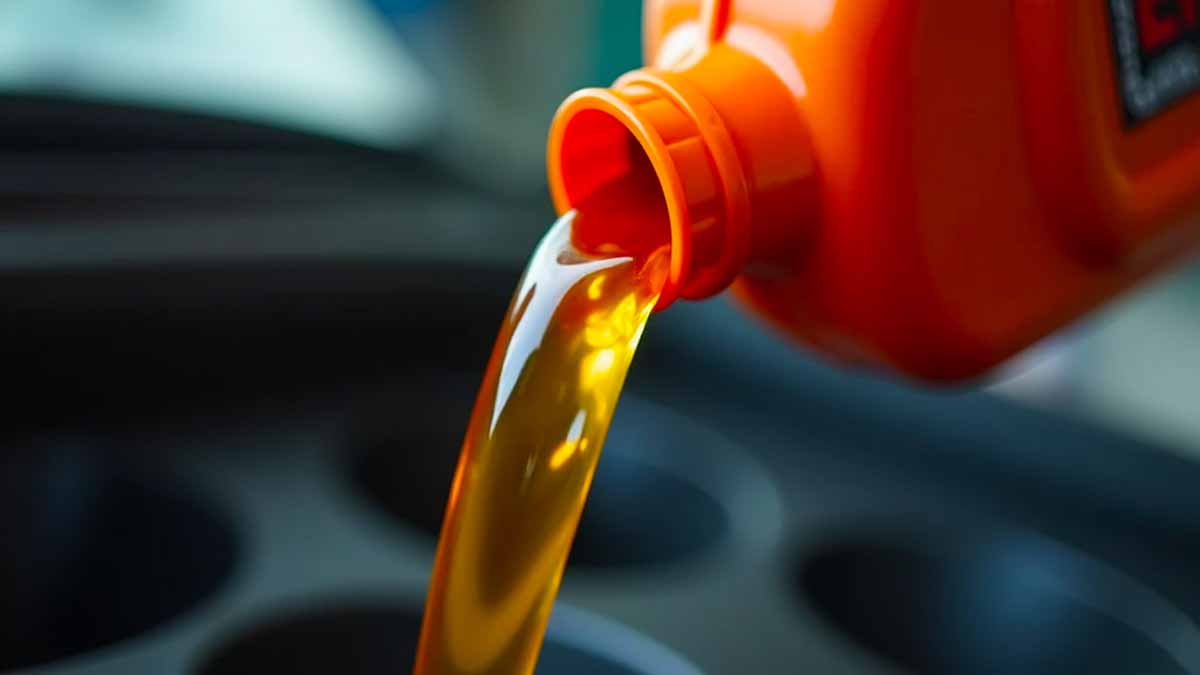Engine oil is a lubricating fluid designed to reduce friction and wear between moving parts inside an internal combustion engine, while also cooling, cleaning, and protecting components from corrosion and deposits.
While we may think that there are numerous car manufacturers globally, as of 2025, there are only slightly over 100 original equipment manufacturers (OEMs), but over 5,000 models. Whether it’s a luxury vehicle or a basic, functional one, they all require one thing to keep them running: lubricants (in the EV market, this can mean greases as opposed to traditional oils).
Parallel to the various models of vehicles, there are also numerous types of lubricants on the market, each designed specifically for different requirements. In this article, we will share some knowledge on the areas you need to be familiar with for these types of lubricants, and of course, what impacts they have on your vehicle of choice.
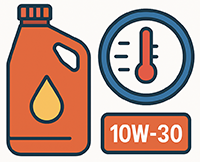 Understanding Viscosity and Engine Oil Grades
Understanding Viscosity and Engine Oil Grades
Before exploring the types of oils, it is essential to understand one of the most important characteristics of oil: its viscosity. This is what governs the engine’s functionality and, to some extent, dictates its performance.
What is Viscosity?
Oil viscosity is the internal friction within an oil that resists its flow. It measures the oil’s resistance to flow and is one of the most important factors in lubricants. Viscosity is also defined as the ratio of shear stress (pressure) to shear rate (flow rate).
The SAE Viscosity Rating System
The SAE (Society of Automotive Engineers) developed viscosity grades to classify engine oils, enabling engine manufacturers and oil marketers to make recommendations and label their products accordingly. The SAE J300 is a series of two viscosity grades: one with the W and one without the W.
Monogrades with the letter “W” are defined by maximum low-temperature cranking and pumping viscosities and a minimum kinematic viscosity at 100°C. (Typically, this represents the start-up condition of an engine.)
Monogrades without the W are based on a set of minimum and maximum kinematic viscosities at 100°C and a minimum high temperature / high shear measured at 150°C and 1 million reciprocal seconds (s-1). (Typically, this represents the operating conditions of the engine when it is in use.)
Multiple viscosity grade oils or multigrades are defined by:
- Maximum low-temperature cranking and pumping viscosities
- A kinematic viscosity at 100°C that falls within the prescribed range of one of the non-W grade classifications
- A minimum high temperature / high shear viscosity at 150°C and 1 million reciprocal seconds (s-1).
These represent the extremes of startup and engine operation.
The table below gives a summary of these.

Figure 1: SAE J300 revised January 2015. Source Widman International SRL
API Certification
The American Petroleum Institute has a dedicated Engine Oil Licensing and Certification System (EOLCS), a voluntary license and certification program that authorizes engine oil marketers who meet the specified requirements to use their quality marks.
It is a cooperative effort amongst additive industries and vehicle and engine manufacturers such as Ford, General Motors, and Fiat Chrysler, which are represented by the Japan Automobile Manufacturers Association and the Truck and Engine Manufacturers Association. The performance requirements and test methods are established by vehicle and engine manufacturers, as well as technical societies and trade associations, including the ASTM, SAE, and the American Chemistry Council (ACC).
While the API initially included designations for both gasoline and diesel specifications, it later established these as two separate classes. Gasoline engines designed for cars, vans, and light trucks were allocated to the “S” or Service category. On the other hand, diesel engines designed for heavy-duty trucks and vehicles fall under the “C” or Commercial category.
These standards have been in place since 1947 and regulate both gasoline and diesel engine oils. One of the major changes since 2020 is the introduction of 0w16 oils, which now have their certification mark, the “shield” instead of the traditional “starburst”.
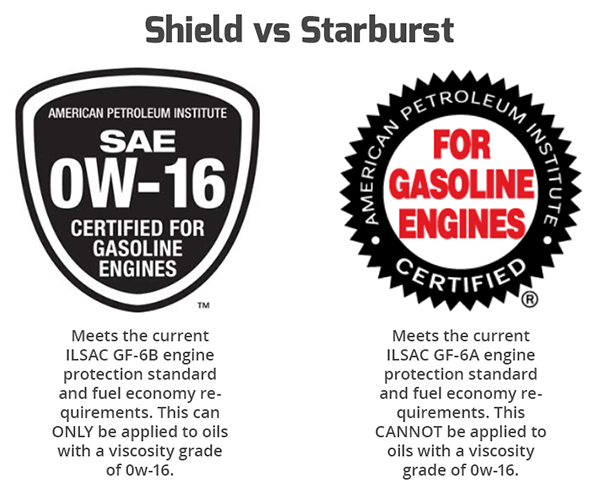
Figure 2: API’s Shield vs Starburst
What’s the main difference between ILSAC GF-6A & 6B?
Both are designed to provide protection against low-speed pre-ignition (LSPI), timing chain wear protection, improved high-temperature deposit protection for pistons and turbochargers, more stringent control of sludge and varnish, enhanced fuel economy, and protection of the emission control system for engines operating on ethanol-containing fuels up to E85. However, ILSAC GF-6B applies only to 0W-16 oils.
The current gasoline engine oil standard is API SP. This standard was introduced in May 2020 and is designed to protect against low-speed pre-ignition (LSPI), provide timing chain wear protection, enhance high-temperature deposit protection for pistons and turbochargers, and implement more stringent control of sludge and varnish.
API SP with Resource Conserving matches ILSAC GF-6A by combining API SP performance with improved fuel economy and enhanced emission control system protection for engines operating on ethanol-containing fuels up to E85.
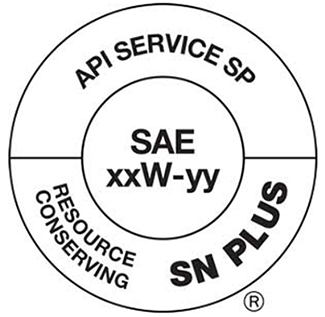
Figure 3: API SP Service Donut
On the diesel side of things, there has been a slight break from tradition, as two new categories, CK-4 and FA-4, have been introduced. The main difference with these is the type of fuel used, specifically in terms of its sulphur concentration. CK-4 is ideally used for vehicles using diesel fuel with 500 ppm (0.05% weight) sulphur, while FA-4 is used for vehicles using diesel fuel with less than 15 ppm (0.0015% weight) sulphur, and they must be Xw30 oils.
CK-4 oils are used in high-speed four-stroke cycle diesel engines designed to meet 2017 model year on-highway and Tier 4 non-road exhaust emission standards, as well as previous models of diesel engines. They are formulated for use with diesel oils containing up to 500 ppm sulphur. However, if they are used alongside fuels containing more than 15 ppm sulphur, this can affect the exhaust after-treatment system durability or oil service drain interval.
They effectively sustain the durability of emission control systems, particularly when particulate filters and other advanced after-treatment systems are employed.
API CK-4 oils are designed to provide enhanced protection against oil oxidation, viscosity loss due to shear, and oil aeration, as well as protection against catalyst poisoning, particulate filter blocking, engine wear, piston deposits, degradation of low- and high-temperature properties, and soot-related viscosity increase.

Figure 4: API CK-4 Service Donut
FA-4 oils are specifically for certain Xw30 oils formulated for use in high-speed four-stroke cycle diesel engines designed to meet 2017 model year on-highway greenhouse gas emission standards. They are formulated for use in on-highway applications with diesel fuel sulphur content up to 15 ppm. These oils are blended to a high-temperature, high-shear (HTHS) viscosity range of 2.9cP – 3.2cP to assist in reducing greenhouse gas (GHG) emissions.
They are effective in sustaining the durability of emission control systems, particularly when particulate filters and other advanced after-treatment systems are employed.
API FA-4 oils are designed to provide enhanced protection against oil oxidation, viscosity loss due to shear, and oil aeration in addition to protection against catalyst poisoning, particulate filter blocking, engine wear, piston deposits, degradation of low and high-temperature properties, and soot-related viscosity increase. It is essential to note that FA-4 oils are not interchangeable or backward compatible with API CK-4, CJ-4, CI-4, CI-4 PLUS, and CH-4 oils.
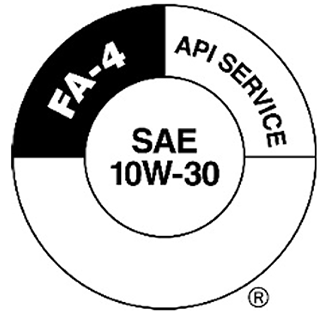
Figure 5: API FA-4 Service Donut
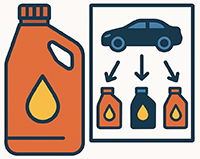 Choosing the Right Engine Oil Grade for Your Vehicle
Choosing the Right Engine Oil Grade for Your Vehicle
This begins with understanding the requirements of your engine and the type of fuel it uses. As we saw above, various classifications exist, and when selecting diesel engines, we must pay particular attention to the concentration of sulphur in the fuel being used. This would be highly dependent on the availability of these fuels in the market, as not all countries have ready access to varying grades of fuel.
All original equipment manufacturers (OEMs) provide a recommended range of oils for your vehicle, typically listed in the vehicle’s owner’s manual. They typically provide various operating conditions and corresponding grades of oils to select. For example, for the Nissan Qashqai 2024 model with the HR13DDT engine, a 5w30 or 0w20 oil is recommended, but the manufacturer also provides this chart to guide the user:
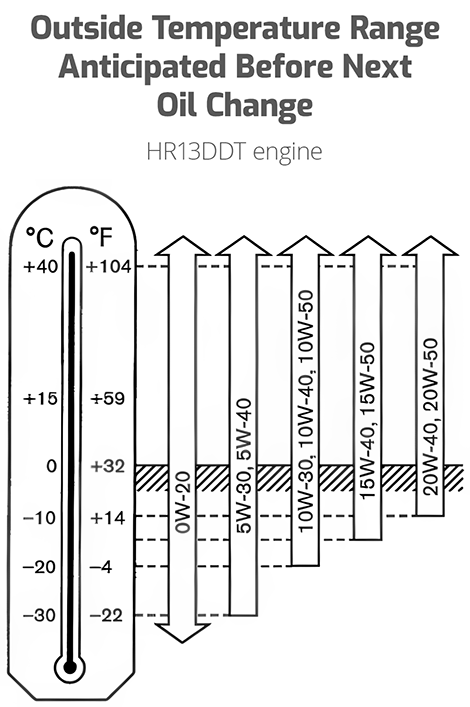
Figure 6: Nissan Qashqai Manufacturer recommendation chart
It is important to consult with your Car manufacturer before purchasing the correct oil for your vehicle.
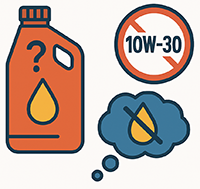 Common Misconceptions about Viscosity and Engine Oil Grades
Common Misconceptions about Viscosity and Engine Oil Grades
Many people believe that “thicker” oil is better for their vehicle. This is the furthest thing from the truth! Over the years, engine sizes have been reduced dramatically. With this size reduction, we can infer that the clearances within the engines have also decreased. Hence, a “thicker” oil from 50 years ago will not suffice in a modern-day engine.
Think of trying to drink molasses with a thick (or wide) straw. This may be possible (although challenging), but if we swapped the thick straw for a thinner, narrower straw, the person would have to use significantly more force to pull up the molasses. A similar phenomenon occurs with engine oils.
In modern engines, the oil lines are narrower, so trying to force a heavier-weighted oil (such as straight 50) would put more pressure on the engine. This is where we begin to see leaks in the engine, particularly at the bottom of the sump near the seals, where the most pressure is exerted during start-up to pump the thicker oil to the top of the engine. However, if we used the correct viscosity of the oil, the engine would not be subjected to this amount of additional pressure. So “thicker” is not always better.
Another common misconception is that the number in front of the “w” in a multigrade oil represents the thickness of the oil, and if it’s zero, then it must be very thin! The number in front of the “w” for multigrade oils represents the viscosity of the oil at start-up conditions (typically 0°F or -17.8°C for Winter).
Hence, the lower the number, the faster the oil will flow at startup. As such, a 0w20 will get from the bottom of the sump to the top of the engine faster than a 20w50. In this case, the 0w20 will provide more protection during startup compared to the 20w50, as most wear occurs during this period.
On the other hand, the number behind the “w” indicates the viscosity at operating temperature. This is where a higher number may not always be agreeable, depending on the year of manufacture of your engine or the ambient conditions. When deciding which oil to use, both numbers (in front of the ‘w’ and behind the ‘w’) are important.
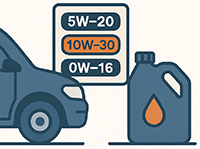 Types of Engine Oils
Types of Engine Oils
When you walk into the auto repair store, it can be quite overwhelming with the barrage of oils readily available for customers. It’s easy to get distracted by the shiny packaging or marketing claims (‘This is the best oil ever!’) when deciding to purchase oil for your vehicle. However, it begins with understanding the basics of engine oils.
Conventional Oil
This is the oil that has been around since the beginning of the automotive revolution. They are also referred to as mineral oils and represent the API Groups I-III base oils. Ideally, these oils can be traditionally found as the base for lubricants that are on the higher end of the viscosity spectrum (think 40, 50, and 60 weight).
These mineral oils are found on the earth, and their molecules may not all be the same size (unlike synthetic oils). They are usually less costly than synthetic oils but still provide some protection to the engines.
Synthetic Oil
Synthetics are considered the top-tier set of lubricants, as they can withstand harsher conditions compared to mineral oils. They are found in groups IV and V, and many of them are man-made, while others are naturally occurring. Most of their molecules are the same size, allowing for better properties, and they tend to be more expensive than mineral / conventional oils.
Synthetic Blend Oil
A synthetic blend oil refers to an oil that contains both synthetic and mineral base oils. However, there is no set ratio of synthetic to mineral oil that can impact the final performance of the lubricant to be classified as a synthetic blend. Many manufacturers can easily get away with using only 1% synthetic oil blended with 99% mineral oil and still label the oil as a “Synthetic blend.”
This gives the customer the false impression that they are purchasing an oil that will offer the best of both worlds.
High Mileage Oil
Until about a decade ago, high-mileage oils were not really that popular, but with the aging population of automobiles, there has been a significant increase in the purchase of this type of oil. Different manufacturers have varying specifications for these oils and typically use the vehicle’s mileage range to help guide customers in selecting the correct oil.
These oils are blended on the “thicker” side of the viscosity range, meaning on the higher end of the maximum viscosity. For instance, a regular 10w40 would appear to be “thinner” than a High Mileage 10w40. They are also reinforced with seal conditioners to help some of the seals in the older engines. But it does not contain magic, so it can’t repair your engine!
Racing Oil
The performance required of a Ferrari compared to that required of a minivan can differ drastically. The operating conditions are starkly different, and the engines would require specifications from their manufacturers. As such, there are specially developed racing oils for these higher-performance vehicles built to withstand harsher conditions compared to the regular engines.
This does not mean that you should use racing oil in your regular vehicle to get the performance of a race car. The oils are blended for specific purposes and must be used accordingly to ensure maximum functionality. Similarly, the oil used in the minivan would not be able to withstand the conditions of a racing car. Use oil that is compatible with the type of engine and the required performance.
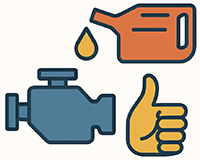 Benefits of Using the Right Engine Oil
Benefits of Using the Right Engine Oil
As we’ve covered in this article, various types of engines require different levels of performance, and engine oils have been specifically designed for these conditions. Hence, it becomes critical to select the right engine oil for your engine. But what are some of the benefits of selecting the right oil?
Improved Fuel Efficiency
Firstly, the primary purpose of a lubricant is to reduce friction between contacting surfaces. By reducing the friction, a smaller amount of energy is required to perform the same amount of work. Overall, this leads to a more efficient system.
When we’re talking about engines, fuel is also required to produce energy for the engine to work. As engine oils have become more advanced, they have enabled significant improvements in fuel efficiency for many engines. This is one of the requirements in the API service categories. By selecting the incorrect viscosity of oil or type of oil for your vehicle, you can negatively impact the fuel efficiency, which in turn adds up to a higher fuel bill at the end of the month!
Longer Engine Life
The occurrence of wear is one of the most common challenges with engines. By using the correct oil (as recommended by the manufacturer), the viscosity of the oil is ideal for keeping the engine surfaces from touching, which can prevent wear.
Additionally, engine oils contain additives that can also help protect the oil and the engine’s components. Hence, with the right oil (as specified by your OEM), your engine will have the ideal conditions it needs to last longer compared to using an oil that does not provide the optimal protection.
Better Engine Performance
Engines were created with particular standards in mind. OEMs designed engines to withstand certain temperatures and conditions. These attributes are passed to lubricant suppliers who would design engine oils capable of withstanding and performing in these conditions. Using the recommended engine oil ensures better engine performance.
For instance, if the customer decides to use an API CK4 oil in their diesel engine but uses 500 ppm sulphur fuel, they can run the risk of poisoning their catalyst or damaging their aftertreatment devices. This would not lead to better engine performance! Therefore, it is essential to follow the OEM’s recommendations to achieve optimal engine performance.
Reduced Emissions
Many of the newer specified oils are designed to reduce emissions. However, the older spec oils were not developed with reducing emissions in mind. Hence, using an older-specification oil (API SL) in a vehicle manufactured in 2024 may not necessarily help reduce emissions. On the other hand, the API SP oil is designed with enhanced emission control in mind, making it ideal for reducing emissions.
Enhanced Lubrication and Protection
If we recall the straw example from earlier in this article, we will realize that engines have been designed for specific lubricants, both in terms of viscosity and additive packages. By using the recommended lubricants, we can ensure that our engines receive the necessary protection and have the correct amount of lubrication to prevent wear. Use lubricants specifically designed for your engine to ensure enhanced lubrication and protection.
 Understanding the Different Engine Oil Change Intervals
Understanding the Different Engine Oil Change Intervals
At the beginning of this article, we reiterated that there are more than 5000 models of engines that exist. Every engine was built to different specifications, but they all provide the user with the ability to move the vehicle. With different manufacturers, there will also be varying oil specifications for each model, including the recommended oil change intervals. Let’s look at some of those.
Factors Affecting Oil Change Frequency
Lubricants are designed for certain conditions; however, if those conditions are exceeded, then the lubricant can degrade at a faster rate. For instance, if the driver frequently starts and stops or experiences prolonged periods of idling, these patterns can stress the oil more quickly, causing it to degrade.
If the fuel quality is not as expected, it may also contribute to the oil degrading more quickly. In such cases, users may opt for shorter oil change intervals to ensure their engine remains protected.
Another factor affecting the frequency of oil changes is the quality of the oil used. Typically, synthetic oils may have longer oil change intervals than mineral oils. However, there are some cases where the manufacturers advise the same interval length, whether mineral or synthetic.
Using Oil Analysis to Determine Engine Oil Life
There are instances where the oil drain interval can be extended beyond the manufacturer’s recommended interval. However, this must be done with guidance from a lab while utilizing oil analysis. Typically, some applications do not utilize the additives in the oil as quickly and may not require the regular oil change interval; instead, the oil remains healthy by the time it’s supposed to be discarded.
This can be considered a waste of resources. With oil analysis, one can monitor the health of the oil and determine if it is nearing the end of its useful life, allowing for informed decisions on whether to change it or not.
The Debate over Extended Oil Change Intervals
There will always be a debate over whether it is wise to extend the oil change intervals for equipment, as it goes against the manufacturer’s recommendations (or, in some cases, this could void the warranty). However, just as with blood testing (or condition monitoring for oil), close monitoring allows us to justify the outcomes of extending the intervals.
Some of the benefits of extending the intervals include reduced manpower, allowing staff to perform other critical duties, a reduction in oil consumption and its disposal, as well as reduced downtime for maintenance. One can also include the reduction of safety risk depending on the application. These all add up in the end, and the benefits of safely extending the intervals may outweigh remaining at the recommended intervals.
The Importance of Regular Engine Oil Changes
Some oil manufacturers claim that their oil, when added to your engine, will remain “golden” in color and not turn dark. Every engine produces soot /carbon as a byproduct, so if the oil does not change color, it means that the soot/carbon is likely remaining stuck on the insides of your engine, which can lead to engine failure.
In these cases, the oil, especially motor oil, contains detergent and dispersant additives that keep the soot or carbon suspended in the oil. This ensures that these deposits do not adhere to the engine’s internal components, causing clogging of smaller clearances and damaging the engine. Hence, an oil change removes these accumulated deposits. There are several other advantages to changing oil regularly for these engines.
Preventing Engine Wear and Tear
Motor oils are formulated with around 30% additives. These additives can perform various functions, including protecting the internal components from wear. However, over time, they become depleted and should be replenished. Changing your oil regularly can help with that. With an oil change, there is a replenishment of additives that protect the equipment.
Maintaining Proper Engine Functioning
Over time, the viscosity of the oil in engines will decrease due to the conditions that exist within the engine. There will come a time when it reaches the end of its life and will no longer be able to protect the engine. At this point, the crosshatch on the cylinder walls can begin to experience some polishing, as the oil can no longer provide the necessary protection. By changing the oil on time or regularly, this can be avoided, and the engine can maintain its proper functioning.
Avoiding Costly Repairs
When the oil starts to degrade, it loses all its protective elements, and wear can start to occur. With frequent oil changes, this can be avoided as new oil will be able to protect the engine and its components to the best of its ability. This way, increased wear can be minimized, and costly repairs can be avoided.
Following Manufacturer Recommendations
Manufacturers typically recommend oil changes every 5,000 to 7,000 kilometers for passenger cars; however, this interval can vary depending on driving habits, environmental conditions, and even the type of fuel used. Oils are designed to protect the engine, and when they reach the end of their life, they can no longer fully perform this function. By changing the oil regularly (or, in some cases, as recommended by the manufacturer), the engine’s lifespan can be extended.
Monitoring Oil Levels and Quality
In some passenger cars, engine manufacturers specify that there is a loss of oil over time. One manufacturer, Audi specifies that owners should top up 0.5 liters of oil every 1000km. As one can imagine, if there is no top-up or oil replenishment, the oil levels can fall below the minimum value, causing damage to the engine.
Hence, it is essential to follow your manufacturer’s recommendations for topping up your engine to prevent damage. These top-ups also serve to replenish some of the used additives, providing additional protection for your engine.
 Effects of Using the Wrong Engine Oil
Effects of Using the Wrong Engine Oil
Sometimes, the wrong engine oil is used. Whether it’s an issue of the unavailability of the correct stock or trying to standardize across the fleet without consulting the manufacturer’s recommendations, numerous issues can arise when the wrong engine oil is used.
Engine Sludge Build-Up
One of the most common side effects of using the wrong oil is a build-up of engine sludge. If we recheck the API standards, oils were designed to reduce sludge formation. When the incorrect oil is used, it cannot adequately compensate for the engine’s conditions, simply because it wasn’t designed for that purpose.
This can also occur when oil is used with an incorrect viscosity or with the wrong fuel (specifically, the concentration of sulphur for diesel engines).
Increased Friction and Wear
Earlier, we discussed how OEMs typically recommend several different types of viscosity for engines, depending on the specific conditions. However, if a viscosity is used that is too low to provide the correct amount of support and separation between the two surfaces, then increased friction and wear can result, damaging the engine’s internals.
Poor Performance and Efficiency
With the incorrect engine oil, the engine will not perform at its expected efficiency. This will directly impact its overall performance. If the viscosity exceeds the recommended value, the engine must work harder to achieve the same results, resulting in poor performance and decreased efficiency. Similarly, if the viscosity is lower than the recommended value, increased friction will result, leading to higher heat and reduced engine efficiency.
Damage to Engine Components
As stated above, a viscosity that is either higher or lower than the recommended value can damage the equipment’s internal components. Similarly, if an incorrectly specified product is used, it may not withstand the engine’s regular environmental conditions and can break down prematurely, damaging its components.
Potential for Engine Failure
Using the incorrect oil, the engine’s components will not receive the necessary protection, whether it’s due to the incorrect viscosity or the wrong mix of additives. This can lead to premature oil degradation, which in turn may result in engine failure. The correct oil will be able to protect against these harmful conditions and keep the engine from failing due to lubricant-related issues.
 How to Properly Dispose of Used Engine Oil
How to Properly Dispose of Used Engine Oil
Changing our motor oil is important and must be done regularly, but how do we dispose of the used oil in a safe and environmentally friendly manner? Approximately 42 gallons of crude oil are required to produce 0.5 gallons of new oil for lubricants. However, only one gallon of used oil needs to be converted into 0.5 gallons of new oil.
Hence, recycling used oil significantly reduces the number of resources required to produce new oil. There are numerous benefits to recycling used oil, which can help in the fight against declining resources. Let’s dive into this a bit more.
Environmental Impact of Improper Disposal
When motor oil reaches the end of its life, it can become contaminated with harmful pollutants, which can negatively impact the environment if improperly disposed of. Some of these can be toxic to plants, and it only takes the used oil from one oil change to contaminate one million gallons of fresh water! Therefore, we need to be mindful of the disposal of our oils.
Used motor oil can typically contain metal fillings (from engine wear), chemicals from by-products, and possibly fuel. Improper disposal, especially into waterways, can disrupt the supply of clean drinking water for many people. If this used oil seeps into the soil, it could also contaminate the water table and negatively impact plants and, by extension, humans who may consume these plants at some point.
Laws and Regulations for Disposing of Oil
The EPA (United States Environmental Protection Agency) provides guidelines in Title 40 of the Code of Federal Regulations, specifically CFR part 279, regarding the disposal of used oil. In the UAE, there are strict guidelines for the disposal of used oil; otherwise, individuals may face severe fines and legal action. These used oils should never be poured down drains, onto the ground, or into bodies of water.
Community Recycling Programs
Some communities have a local collection point for used motor oils, which they then take to the larger refineries. This way, a larger volume of oil is collected and recycled by the refineries.
Tips for Safe and Responsible Oil Disposal
Motor oils contain 30% additives; therefore, mixing them with other used oils may not be the best option for those trying to recycle them. Ideally, these oils can be reconditioned (where they are cleaned up) or re-refined (where they are reused as base stock). Collecting your used motor oil in a clean container and taking it to your local recycling facility, where it will be properly disposed of.
Some facilities may burn it to process it for energy recovery, using it as fuel after removing the water and contaminants. One gallon of used oil processed for fuel contains about 140,000 British thermal Units (Btus) of energy. Regardless of the method you choose to dispose of your used motor oil, ensure you do not harm the environment.
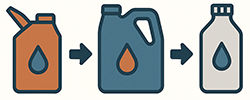 The Evolution of Engine Oil
The Evolution of Engine Oil
History of Engine Oil
Over time, engine oils have undergone significant evolution. Initially, there were only monograde oils, which had to be replaced seasonally. During the summertime, one oil could withstand the higher temperatures, and during the winter months, another oil was designed for those cold starts. This eventually led to the multigrade revolution, which allowed for the best of both worlds.
As we transitioned from monograde to multigrade, developments in the base oil sector continued, and we saw the rise of Group II mineral base oils. This eventually led to increased the production of Group III base oils and the development of their “hybrid” or Group III+ counterparts, which exhibit quasi-synthetic traits. As we evolved, introducing synthetic base oils as first fills for cars also became a new trend.
We have also seen the transition of straight mineral oils (50 or 60 weight) go down to 0W-16, unfathomable 20 years ago. The introduction of high-mileage oils was also a significant change in the industry, as cars became older, but owners needed to preserve their engines.
Over time, OEMs developed more specific standards as they designed their engines with greater precision, smaller spaces, and higher horsepower. One such standard is the BMW LL04 oils, which are fully synthetic and branded as long-life oils. This standard did not exist 50 years ago!
Improvements in Oil Technologies
Oil technologies have undergone significant improvements over the years. From refined base stocks to more balanced additives that consider the full impact of the oil, technology continues to improve. Technologies were forced to improve as OEMs made engine sizes smaller and more compact, but placed the oil under more stress. As such, oil manufacturers had to develop new methods to address more complex oil handling issues.
Shift Towards Synthetic Oils
Synthetic oils offered a solution that provided longer oil life and withstood harsher conditions compared to mineral oils. These oils provided the protection needed by more modern engines. Today, many auto manufacturers explicitly state that they prefer the use of fully synthetic oils in their engines for the entire lifetime of the vehicle.
Future of Engine Oil
Gasoline and diesel engines are likely to remain in use for quite some time. They won’t be coming off the market soon, as it would require 80% of the car population to have an early retirement. The spin-off to this is that car owners would also have to make significantly large investments in new vehicles.
We are witnessing the rise of alternative fuel engines, such as methanol and hydrogen, which are gradually making their way into mainstream areas. Even if it’s a new fuel source for engines, one thing that will not change is the need for moving parts. In any engine, there will always be moving parts that require some form of lubricant to reduce the friction, heat, and wear that can be generated.
Therefore, there will always be the need for lubricants, it’s just that the application and type may change or evolve over time.
Impact of Electric Vehicles on the Engine Oil Industry
One of the major developments in the automotive industry was the introduction of electric vehicles. However, one may argue that this concept has been around for more than 50 years; however, it has only recently entered the market due to an increase in manufacturing capability.
Many oil suppliers initially thought that this was the end of passenger car motor oils since the main “engine” was now an electric motor. However, this just changed the mode of lubrication to more grease applications for this part of the vehicle.
While electric vehicles are expected to continue growing in various markets, we can anticipate a decline in the volume of engine oil consumed. However, this does not mean that the innovation with engine oils will stop. More likely than not, it will continue as engine manufacturers are pushed to greater limits regarding carbon emissions and other stringent regulations.
References
American Petroleum Institute. (2023). API 1509 – Engine Oil Licensing and Certification System – Annex F. Washington: API Publishing Services.
American Petroleum Institute. (2025, January 18). API’s Motor Oil Guide. Retrieved from American Petroleum Institute: https://www.api.org/-/media/Files/Certification/Engine-Oil-Diesel/Publications/Motor%20Oil%20Guide%201020.pdf
American Petroleum Institute. (2025, January 18). Engine Oil Licensing & Certification System (EOLCS). Retrieved from American Petroleum Institute: https://www.api.org/products-and-services/engine-oil
Gulf Oil Lubricants. (2025, January 19). Your guide for using and disposing of Car oil. Retrieved from Gulf Oil Blog: https://me.gulfoilltd.com/en/blog/your-guide-for-using-and-disposing-of-engine-oil
Mathura, S. (2023, March 26). Oil Viscosity: A Practical Guide. Retrieved from Precision Lubrication Magazine: https://precisionlubrication.com/articles/oil-viscosity/
Motorway. (2025, January 18). How many different car brands are there? Retrieved from motorway: https://motorway.co.uk/sell-my-car/guides/how-many-different-car-brands-are-there
Sinclair Group. (2025, January 19). Do I need to top up my Audi’s engine oil. Retrieved from Sinclair Group: https://www.sinclairgroup.co.uk/news/audi-engine-oil/
United States Environmental Protection Agency. (2025, January 19). Managing Used Oil: Answers to Frequent Questions for Businesses. Retrieved from United States Environmental Protection Agency: https://www.epa.gov/hw/managing-used-oil-answers-frequent-questions-businesses
United States Environmental Protection Agency. (2025, January 19). Managing, Reusing, and Recycling Used Oil. Retrieved from United States Environmental Protection Agency: https://www.epa.gov/recycle/managing-reusing-and-recycling-used-oil

